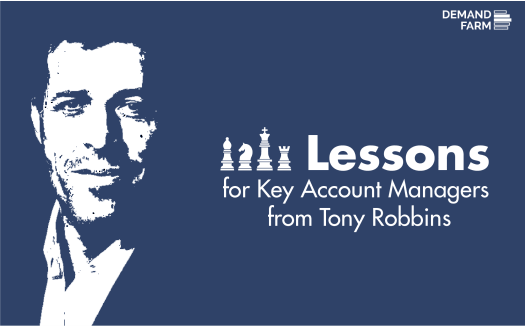Digital Key Account Management- Unlocking the secret to managing Key Accounts

Previously published under the Council Post for the Forbes’ Business Development Council The Pareto principle, better known as the 80/20 rule, is applied for numerous purposes in boardrooms all over—but the essence holds true for a majority of cases in the business world, especially when it comes to managing and retaining customers. The idea and allure of gaining new users always outweigh the duty of catering to existing customers. And it makes sense why: More customers result in better streamlining of resources and approaches, leading to more savings, higher profits, and better output. But this shouldn’t come at the cost of key accounts contributing to the company’s ongoing revenue. Handling these key accounts is often considered an art. As anyone with knowledge of the enterprising history of business would know, it is only the suavest, sociable account managers who can manage relationships between organizations that are mutually beneficial. The roots and troubles of Key Account Management At the peak of the industrial age, about 50 to 60 years ago, businesses differentiated between strategic customers and regular ones. They treated their large accounts preferentially, and the practices to maintain a big account were translated into methodologies which led to creating templates. This led to a layer of complexities in which consultants would create a sometimes 50-page template to manage a key account. Over the years, this has become theoretical and no longer actionable. In the end, account managers end up creating account plans which amount to nothing but filling in the fields of complex templates which may never be referred to again. What began as an initiative to improve product and solution quality by focusing on the most valuable customers has turned into a complex process that is, at best, seen as a nuisance. And at worst, it can harm relationships between organizations. The cracks in traditional key account management practices have proven untenable in the current scenario, where it is often impossible to have a meeting in person. The fundamentals of account management, which relied on keeping in touch with key clients, are no longer viable across industries and verticals. This luxury of time doesn’t exist in the current scenario, as customer preferences change regularly. The representatives for key customers are looking for a partner who can empathize and help them succeed in their business roles, not a cog who provides what is necessary for the supply chain. When organizations treat their key accounts as strategic partners, the real value of relationships can be seen. Finally, a renewed focus on individual careers has made the movement of employees between companies much more common. This often means that the traditional KAM data is rendered obsolete much more quickly. Why Key Account Management? Even after all the drawbacks, organizations keep trying to accomplish key account management the traditional way because it yields results. Yet key accounts are responsible for 33% of sales revenue, according to a survey by Gartner. A poll on Analytics and Advice for B2B Leaders by Gallop shows that organizations that excel at key account management see disproportionate account growth solely by their ability to engage their customers. The numbers are impressive, too: 34% more profitability, 50% more sales and revenue, and 33% greater chance of being the top choice of clients for future business. The results can be seen fairly early as well. One survey shows that customer satisfaction increases by 20% within a few years of establishing a key account management program, which usually is reflected by a 15% increase in profits and revenue. The benefits compound over time, as KAM programs that are operational for five-plus years usually report figures that are nearly double. Taking the Digital Way Ahead With digital account planning, we are seeing a significant shift for the good in the area of strategic account management. B2B companies that had the luxury of time in the past are moving at a faster pace. The employees typically lasted for years in one organization and often could negotiate multi-year deals to provide products, parts, or services. This is almost unheard of in this era of constant change and optimization and one-year contracts. But when the focus was on keeping the client representative happy earlier, account managers could span out their planning across multiple years at once. Digital tools help in key account management by ushering in a new way of business. Digital key account management transforms key account planning into a dynamic, data-driven process that provides actionable information and insights. The intelligence present in the organization regarding its key customers—what one might term tribal knowledge—resides in the way clients and key account managers interact and add value to the relationship. But this seemingly unstructured information can be captured into an enterprise memory which can be replicated or used by a team rather than a single person. What the Future holds With the record created by digital key account management, an enterprise memory is built which narrates the story of a client’s needs and problems. This provides a solid start to those filling in for their colleagues or replacing someone. With the help of these tools, employees can approach the problem of managing a key account more creatively and provide the necessary human touch with efficiency. The cognitive skills of account managers still rule the roost, and no level of automation can replace the intuition an experienced key account manager brings to the job. It can only enhance it.
4 Lessons for Key Account Managers from Tony Robbins

It’s that time again! When you watch the future unfold right in front of you! Yes, Dreamforce’16 is right around the corner, due next month! Did you get a chance to check out the keynote speakers this year? I was super curious, and I’m sure so are you, but Salesforce has only confirmed a handful of speakers so far. The good news is that among those is already the who’s who of leaders, thinkers, and innovators, plus one of my all-time favorites – the “Michael Jordan” of thought leaders – Tony Robbins. A recognized authority on the psychology of leadership, negotiations, and business turnaround, Tony Robbins, is the nation’s #1 Life and Business Strategist. When it comes to making a positive difference in people’s professional life, there is nobody in the game with stronger credentials than Tony Robbins. And like on millions of others, he’s made a significant impact on me too. Inspired by what’s to come in his session, I scoured the web to remind myself of some of his best nuggets that I found Evergreen for all professionals, including Key Account Management practitioners like us: 1. Know who to know: In his own words, Tony Robbins said one of the most amazing pieces of advice he ever received was “proximity is power.” His journey to becoming a great leader included positioning himself in proximity to the people who possessed the expertise, skills, knowledge, and connections that he could access directly. Such an approach opened various opportunities that helped achieve his goals. As KAM Leaders, one of the biggest challenges is to first identify the key stakeholders internally and externally. Large organizations have a web of complex and dynamic networks. The trick is really to identify, nurture and leverage – at the opportune time – the right relationship mapping, make the right connections and join the dots to spot the not-so-obvious opportunities. Building trust internally and client-side requires proximity, understanding, and acumen all at once. It’s also critical to make oneself accessible to the stakeholders and win their trust. I’ve found the possibilities to be endless when I’ve made relationship management central to my approach. 2. Shift focus from creating products to creating value: According to one of the “7 Forces of Business Mastery” defined by Robbins, it is imperative to understand, anticipate and realize the deepest needs of our customers consistently. The more value we create for our customers, the more we can dominate the marketplace. Sounds simple but practitioners will obviously know the myriad complexities hidden under this seemingly simple statement. It takes a lot to keep tabs on the dynamic landscape – be it customer industry and business goals, competitor offerings, regulatory needs or our own capacity. It takes a lot to build a watertight internal business case to invest in new capabilities because that’s where we believe the customer needs us to go. The idea is not to fall in love with our product or service, but to fall in love with the client and their needs, fears, goals. This way we have the right knowledge to create more value for clients than anybody else. 3. Embrace the magic of ‘strategic innovation’: When Robbins said that, as a leader, you have to strategically innovate; he meant being better than what currently exists. Not just in product, but in processes, service, delivery – every facet. Strategic Account Planning innovation is another pillar for creating unbeatable value for customers. Now here is the thing about innovation that struck me. It doesn’t have to be fancy; it doesn’t have to be the responsibility of unseen wizards sitting in the ‘innovation department.’ You get my drift. In fact, my favorite Tony Robbins phrase is ‘innovation is a daily habit.’ So how do we constantly identify new opportunities to serve customers better through fresh and inventive approaches that also help meet their goals? In my experience, the key is real-time knowledge available to all team members. If all internal stakeholders know what is going on now, that gives us multiple perspectives and multiple ideas and therefore multiple possibilities to innovate. Less time spent on admin and housekeeping tasks, more on collaboration and connection. 4. Keep your eye on the goal: Today’s Key Account Manager skills include a sharp track of the business results even before the client notices a declining goal metric. Robbins points out that opportunities for maximization are plenty such as lead generation, conversions, sales, etc. The key is to document the results in each area and anticipate the challenges that hinder efforts to achieve goals. Because you can’t manage what you don’t, measure. Measuring an outcome further mobilizes the team to work on key areas of improvement and further cement positions of strength. In my years as a Key Account professional, I’ve found that quantifying the qualitative and qualifying the quantitative is a real art, and can hold the key to success. It is easier said than done, of course. Managing Key Accounts is both – art and science. Finding a balance between the two is something I take both as a personal challenge and a key focus area for innovation with my company, DemandFarm. Needless to say, Account Managers are the cornerstone of the organization, responsible for a bulk of the revenue from just a few strategic customers. Following Tony’s advice can certainly help up the chances of success. What are your favorite Tony Robbins insights? We’d love to hear them and how you used them in the Account Management Context! Write in and share the secrets!
Annual Planning Pains

It’s that time of year again folks. Yes. Holiday time, Thanksgiving time, Fall time…but also account planning time! Holiday plans, travel plans…and of course, Annual Key Account Plans! You know that adage- if you fail to prepare, prepare to fail! I had that in big bold letters up in my schoolroom back in high school. While it’s 100% true, it doesn’t change the fact that planning time is a big pain. KAM in simpler days and times Before I turned entrepreneur, I was a Key Account Manager with a large automotive giant. And this time of the year, usually meant taking stock of a lot of data from around the company- all on paper in those days- and trying to pore over all the numbers from all the sources and making sense of them, mobilizing my sources to see what the Client was planning for their year to come, strategizing with the leadership to develop my path for the year and of course, bracing myself for the internal sell, in case some major initiatives were needed to remain competitive. The more things change, the more they remain the same. Today, the very definition of key Accounts has gone from large companies to ultra-global matrix organizations, connected digitally across a complex network of relationships, tracking people’s movements across the globe, mountains of data across myriad formats- from PowerPoints to emails to the cloud…everywhere! In real-time…how simple my Key Accounts of yours seem in comparison…with easier lines of command, few verticals, and even fewer geographies. Shaking off the nagging doubt that ‘somethings been missed’… My compatriots in contemporary Strategic Account Management tell me that the sheer complexity of large Accounts today is not the real challenge- the challenge is managing all the data that is generated, and interpreting that to create strategic action points or annual plans. It’s simply not feasible for one individual to manage it manually – even with the help of software and a laptop. It’s amazing how many productive hours are wasted- yes, wasted– in simply collating the data required to start the process of annual planning – so many formats, so many sources. And even then, one can’t be sure if an opportunity to expand or grow has simply been missed or fallen through the gaps because one entity or buying unit or geography or vertical of the Key Account was missed out, or a certain connection wasn’t established with the right person at the right time in the client organization, or a new business vertical was recorded as an independent entity in the CRM system and didn’t show up in the Account data at all… Over to #painfreeplanning So obviously, technology can help track and collate everything better, and overall plan better, and there are lots of tools to make that happen…but the real secret sauce to shift the focus from managing to growing is to spend productive hours on data interpretation and strategic action, not on joining the dots and collating data from various sources, figuring out version control of the many PPTs floating around or cutting and pasting financial data from excel sheets. At DemandFarm, our inspiration is to create #painfreeplanning for KAMs everywhere. Our technology joins the dots and collates all the data in one format, in one place, right inside your CRM. You won’t believe how pain-free it can be till you try it yourself. And, all this month, we are giving you that opportunity. Experience the DemandFarm Salesforce Account Planning module – free for two months; no questions asked – and see if it works for you. More than a thousand Account Managers across verticals have already made the switch…it’s time you experience why. Happy Thanksgiving, Fall, and the upcoming festive season. Most of all, happy #painfreeplanning!